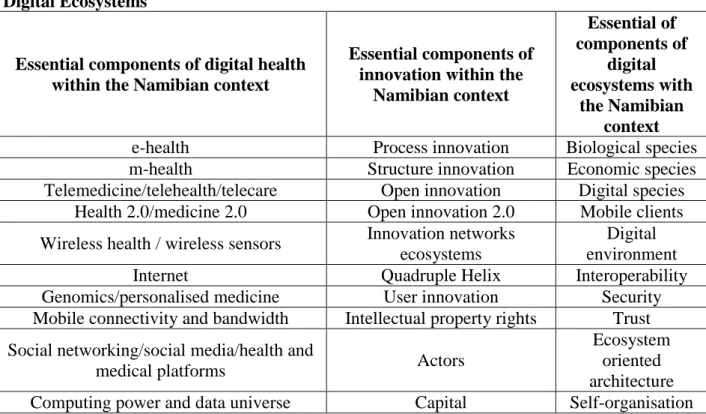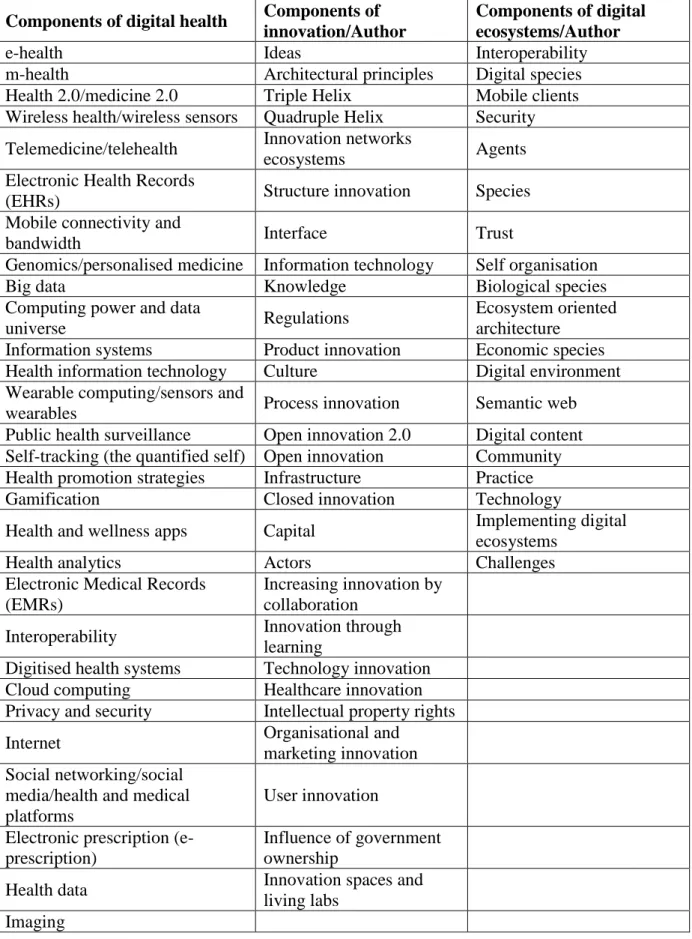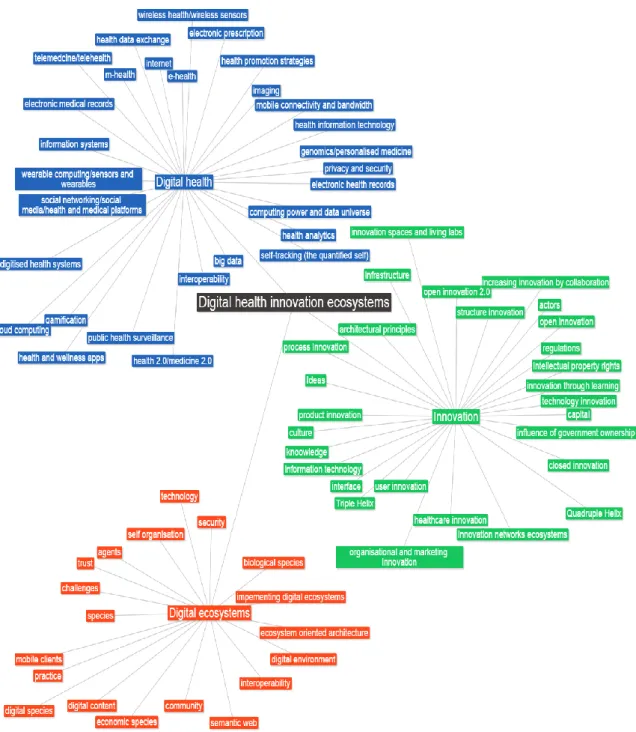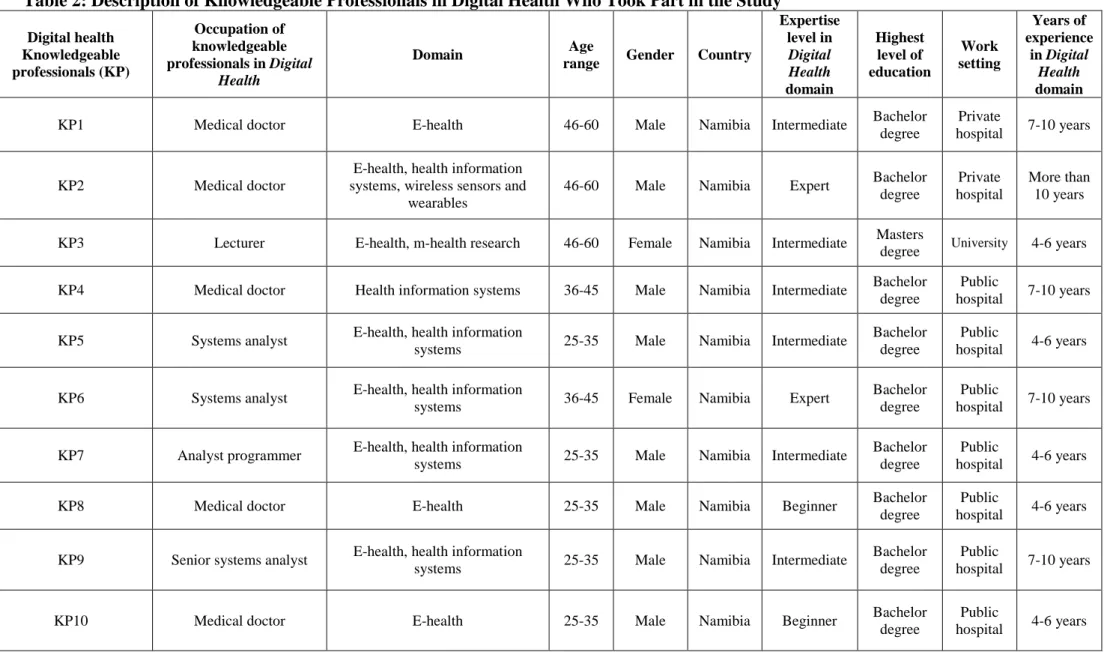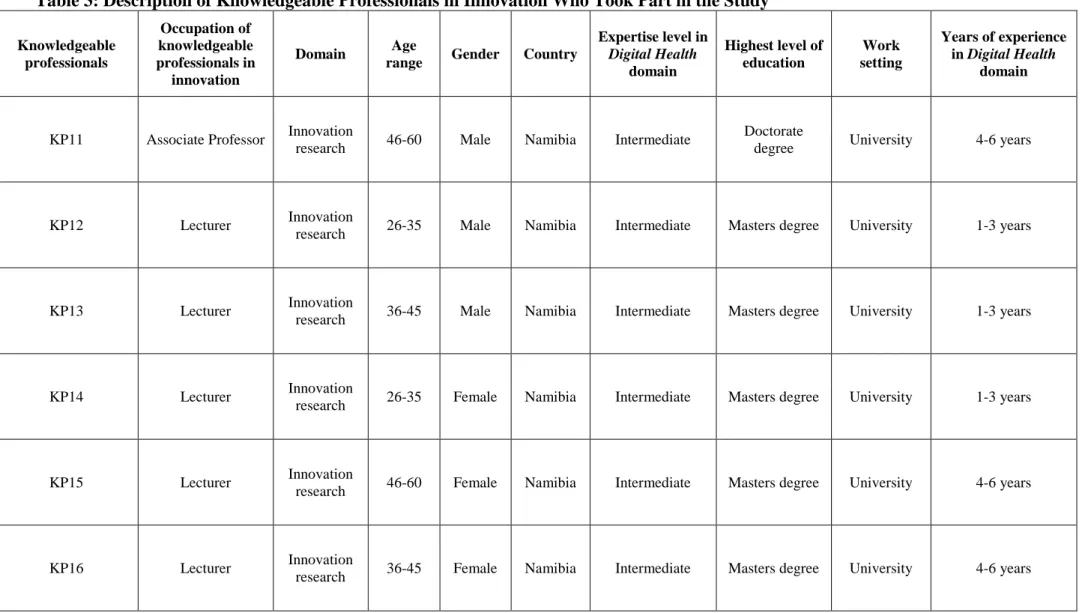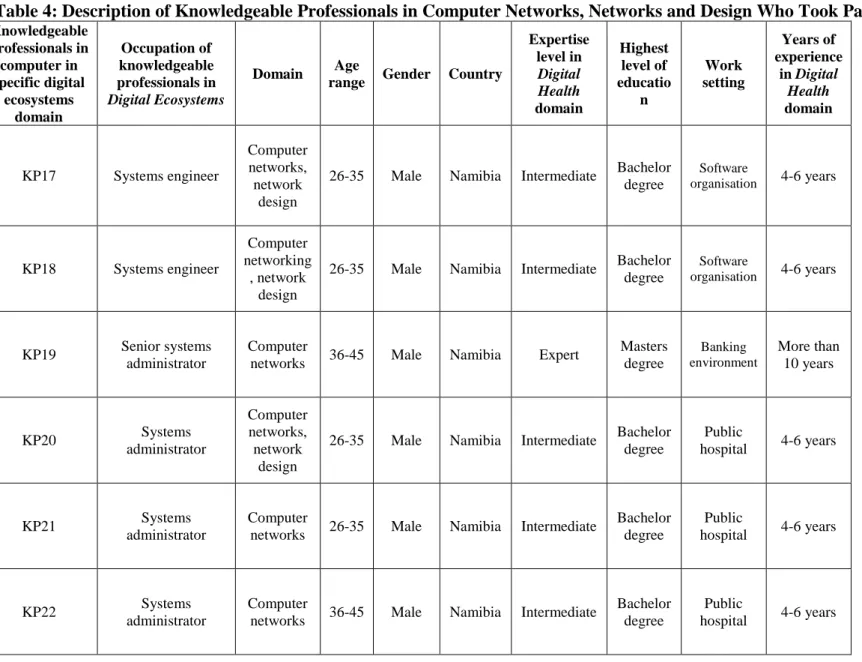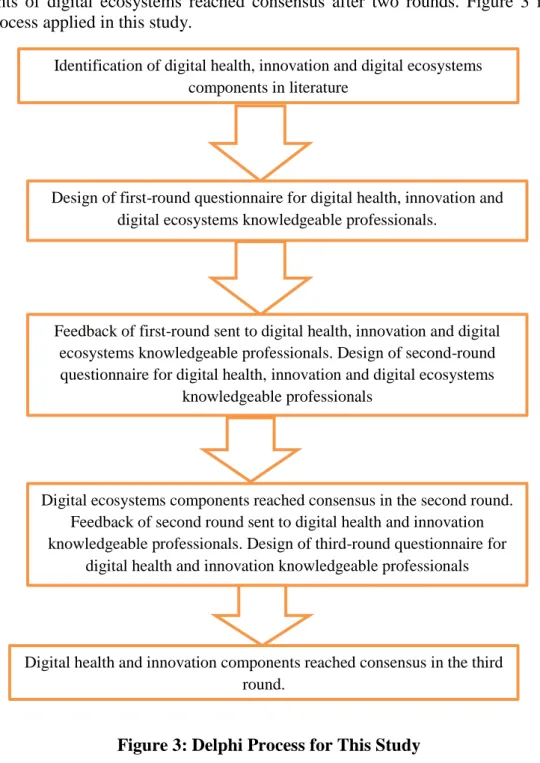2016b) indicate that the definition of a digital health innovation ecosystem incorporates the concept of digital health, innovation and digital ecosystems, and as a result it is important to incorporate the components of digital health, innovation and digital ecosystems when implementing a digital health innovation ecosystem in any link. In addition, Iyawa et al. 2016a; 2016b) identified the components of digital health, innovation and digital ecosystems needed in a digital health innovation ecosystem. Despite the identification of the components of digital health, innovation and digital ecosystems necessary in a digital health innovation ecosystem in the literature (Iyawa et al., 2016a; . Iyawa et al., 2016b), it is less clear which specific components of digital health, innovation and digital ecosystems constitute a digital health innovation ecosystem for the Namibian context.
The aim of this paper was to identify the essential components of digital health, innovation and digital ecosystems relevant to the development of a digital health innovation ecosystem for the Namibian context. This is particularly relevant as the conceptualisation of digital health for the Namibian context is in its infancy. As suggested by Iyawa et al. 2017), for a digital health innovation ecosystem to be established, there must be specific components from the domains of digital health, innovation and digital ecosystems to be identified.
As shown in Figure 1, a digital health innovation ecosystem consists of the components digital health, innovation and digital ecosystems. The combination of digital health, innovation and digital ecosystems components identified by Iyawa et al. A brief description of the professionals purposefully selected to participate in the evaluation of key digital health components in the Namibian context is provided in Table 2.
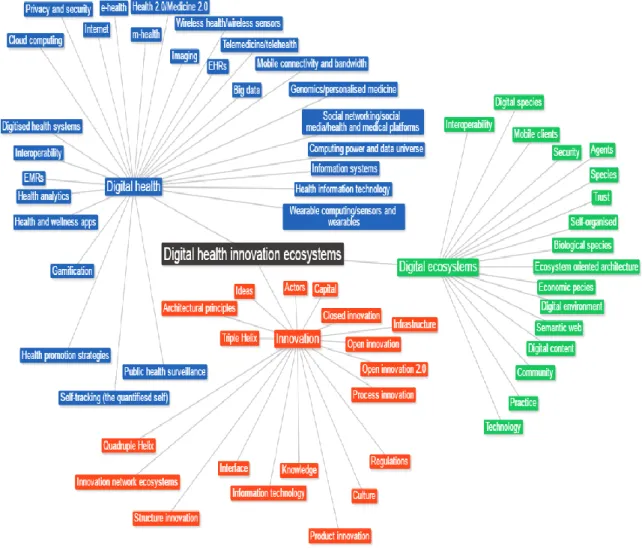
Data Analysis
The key point noted in Delphi studies is that the participants remain unknown to each other in order to avoid chances of dominating an opinion based on the influence of a particular participant (Hsu & Sandford, 2007). This principle was also applied in this paper as the results of the previous round were shown anonymously to all participants. The most important tool used to conduct the surveys in Delphi studies is the use of questionnaires (Morgan et al., 2016; Evans et al., 2016).
Online questionnaires were used to obtain feedback from participants who participated in this study. As part of filling out the questionnaire, the participants also had to give their consent to participate in the research.
The results of the first round were presented anonymously to participants, who were asked to see the rankings and comments of other knowledgeable digital health professionals as well as their own rankings and comments. The selected knowledgeable digital health professionals were asked to reconsider ranking (n=5) the components again as the components did not reach consensus in the first round. In the second round, (n=4) components of digital health met the range of 4-5 and were considered relevant to the Namibian context. n=1) component (gamification) did not reach consensus among selected knowledgeable digital health professionals because the mean fell between 3 and 4.
Regarding digital health, there appears to be consensus on most of the components identified among qualified digital health professionals. This could be an indication that the components of digital health identified in the literature are relevant to the Namibian context. Health data exchange was not considered an appropriate component of digital health in the Namibian context, this may be because health data exchange and interoperability are similar concepts, so trained professionals considered health data exchange and interoperability as repetition.
The findings also revealed that digital health components such as telemedicine/tehealth, e-health and m-health were considered essential components for the development of a digital health innovation ecosystem for the Namibian context.
Innovation 1. Round 1
The questionnaire included the components that did not reach consensus in round 1, as shown in Table 4. n=23) components that reached consensus in the first round were presented to the 10 selected knowledgeable digital health professionals, however, the components could no longer be assessed. However, it took two or three rounds to reach consensus on some components such as genomics/personalized medicine, computing power and data universe, imaging, digitized health systems and gamification. One explanation for this could be that these terms are not popular in the Namibian health context.
This is consistent with other studies showing that telemedicine (Cilliers & Flowerday, 2014), e-health (Kalema & Kgasi, 2014) and m-health (Noutat et al., 2016) are considered important in developing countries . irrelevant to the Namibian context. n=9) components did not reach consensus among the selected qualified innovation experts because the central tendency fell between 3 and 4. The questionnaire included all components that did not reach consensus in round 1, as shown in Table 6. n= 15) components that reached consensus were presented to 6 selected experts with knowledge in the field of computer networks, planning and network analysis, but the components could no longer be evaluated. The results of the first round were presented anonymously to the participants and they were asked to view the rankings and comments of other knowledgeable experts in computer networking, network design and analysis, as well as their own rankings and comments.
In addition, in round 2 'research and development' was presented to the expert professionals, available to be reviewed. The selected expert innovation professionals were asked to reconsider the ranking of the (n=9) components as the components failed to reach consensus in the first round, as well as the new component proposed in round 1. In the second round, (n=5) components of innovation met the 4-5 range and were considered relevant to the Namibian context. n=5) components (product innovation, open innovation, Triple Helix systems, infrastructure and culture) failed to reach consensus among selected expert professionals in innovation because the average fell between 3 and 4.
Product innovation, open innovation, Triple helix Systems, infrastructure and culture reached consensus in the third round. In relation to innovation, components such as closed innovation and product innovation were considered irrelevant to the Namibian context. This may be as a result of the open innovation being demonstrated through the existence of Demola as an innovation model (National Commission for Science and Technology Research, 2016) in Namibia, following a recent contract between Demola and the Namibian government. 2016) imply that open innovation is considered important for developing countries, which is in line with the findings of this study showing that professionals with knowledge in the field of innovation consider open innovation as a component of innovation important for the development of a digital health innovation. ecosystem for the Namibian context.
Product innovation can be considered irrelevant, although it has been identified in developing countries (Selfano & . Robert, 2014; Waribugo et al., 2016) because products should not be produced in a digital health innovation ecosystem, rather services are produced in the digital supply. health innovation ecosystem.
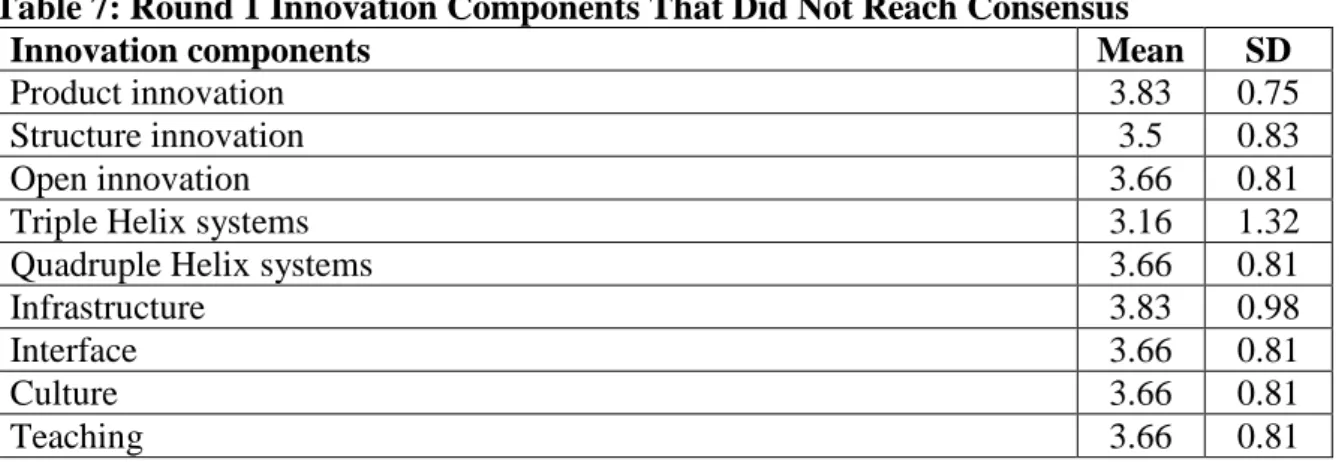
Digital Ecosystems 1. Round 1
The aim of the study was to identify the essential components of digital health, innovation and digital ecosystems to develop a digital health innovation ecosystem for the Namibian context. To the researchers' knowledge, this is the first study to identify essential components of digital health, innovation and digital ecosystems relevant to the development of a digital health innovation ecosystem for the Namibian context. The components of digital health, innovation and digital ecosystems relevant to the development of a digital health innovation ecosystem for Namibia can be visualized in Figure 4.
The contextualized components of the digital health innovation ecosystem for the Namibian context support the concepts of digital health, innovation and digital ecosystems as presented by relevant stakeholders of the Namibian context. The novelty of this study lies in the identification of the essential components of digital health, innovation and digital ecosystems relevant to the development of a digital health innovation ecosystem for the Namibian context. The purpose of this questionnaire is for you to identify and rank relevant components of digital health within the Namibian context.
Please rank "e-health" as a component of digital health relevant to the Namibian context from 1 as not important to 5 as most important. Please rank "m-health" as a component of digital health relevant to the Namibian context from 1 as not important to 5 as most important. Please rank "Health 2.0 / medicine 2.0" as a component of digital health relevant to the Namibian context from 1 not important to 5 most important.
Please rank “internet” as a component of digital health relevant to the Namibian context, from 1 is not important to 5 is most important. Please rank “information systems” as a component of digital health relevant to the Namibian context, from 1 is not important to 5 is most important. Please rank “imaging” as a component of digital health relevant to the Namibian context from 1 is not important to 5 is most important.
Please rank “self-tracking (the quantified self)” as a component of digital health relevant to the Namibian context, from 1 is not important to 5 is most important. Please rank “health information technology” as a component of digital health relevant to the Namibian context, from 1 is not important to 5 is most important. Please rank "Gamification" as a component of digital health relevant to the Namibian context from 1 is not important to 5 is most important.
Please rank “Interoperability” as a component of digital health relevant to the Namibian context, with 1 being not important and 5 being the most important. Please rank “Health Analytics” as a component of digital health relevant to the Namibian context, from 1 being not important to 5 being most important. Please rank "open innovation 2.0" as a component of innovation relevant to the Namibian context, from 1 being not important to 5 being the most important.
